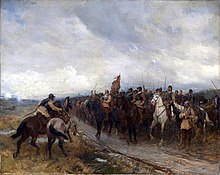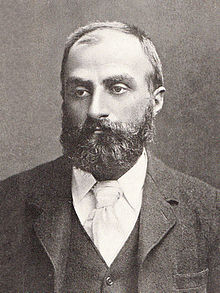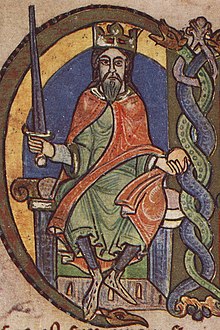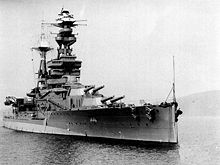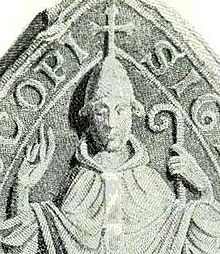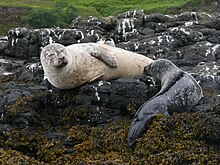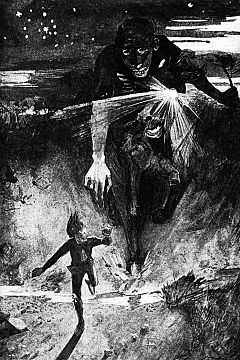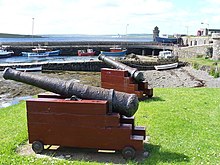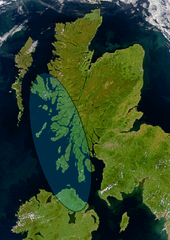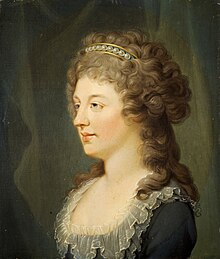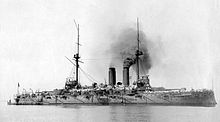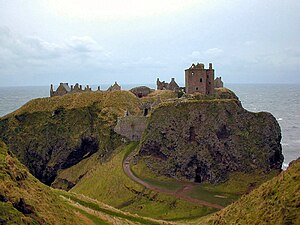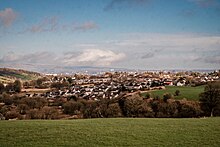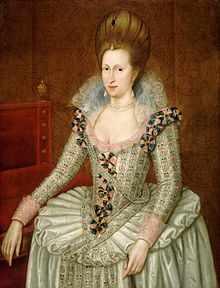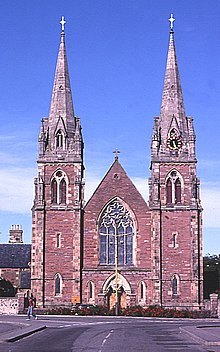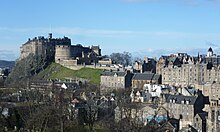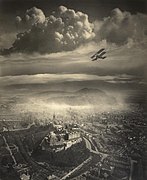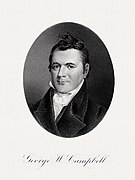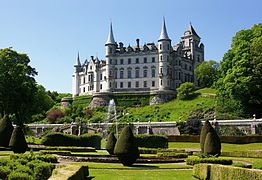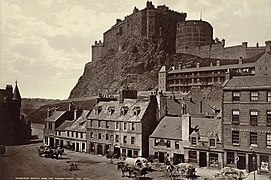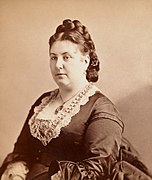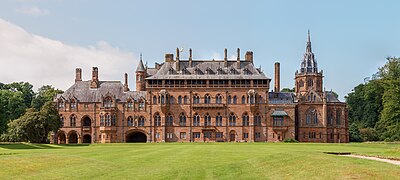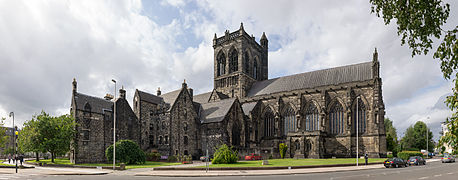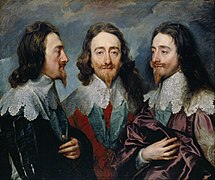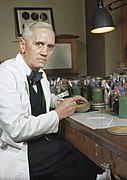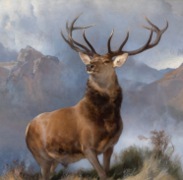Portal:Scotland/Featured
The Scotland Portal
View from An Teallach
| Main Page | Selected articles 1 | Selected articles 2 | Selected biographies | Selected quotes | Selected pictures | Featured Content | Categories & Topics |
Selection of featured articles
Selection of good articles
Elcho Castle (/ˈɛl.xoʊ/) is located close to the south bank of the River Tay approximately four miles south-east of Perth, Scotland, in the region of Perth and Kinross. It was maintained by Clan Wemyss from its construction around 1560 until it was put into the care of the Secretary of State for Scotland in the early 20th century, though was not occupied for the entire time. In around 1830 it was re-roofed and a nearby cottage constructed. The castle has been a scheduled monument since 1920 on the grounds of being "a particularly fine example of a Medieval tower-house", and the cottage became a listed building in 1971 in recognition of its national importance. The castle is unusual in that it has both en suite guest accommodation like a mansion, but also a large number of gun loops. (Full article...)
The Cookery Book of Lady Clark of Tillypronie is a book of recipes collected over a lifetime by Charlotte, Lady Clark of Tillypronie (née Coltman, 1851–1897), and published posthumously in 1909. The earliest recipe was collected in 1841; the last in 1897. The book was edited by the artist Catherine Frances Frere, who had seen two other cookery books through to publication, at the request of Clark's husband.
The book is considered a valuable compilation of Victorian era recipes. Lady Clark obtained the recipes by asking hostesses or cooks, and then testing each one at Tillypronie. She documented each recipe's source with the name of her source, and often also the date. There is comprehensive coverage of plain British cooking, especially of meat and game, but the book has sections on all aspects of contemporary cooking including bread, cakes, eggs, cooking for invalids, jams, pies, sauces, sweets (puddings) and vegetables. She had lived in Italy and France, and the cuisines of these countries are represented by many dishes, as is Anglo-Indian cooking with a section called "Curries". (Full article...)

Glenrothes (listen; /ɡlɛnˈrɒθɪs/, glen-ROTH-iss; Scots: Glenrothes; Scottish Gaelic: Gleann Rathais, pronounced [kʲlən̪ˠˈrˠahɪʃ]) is a town situated in the heart of Fife, in east-central Scotland. It had a population of 39,277 in the 2011 census, making it the third largest settlement in Fife (behind Dunfermline and Kirkcaldy) and the 18th most populous locality in Scotland. Glenrothes is the administrative capital of Fife, containing the headquarters of both Fife Council and Police Scotland Fife Division and is a major service centre within the area.
Planned in the late 1940s, following World War II, as Scotland's second new town its purpose was to generate economic growth and renewal in central Fife. Initially this was to be done by providing new homes, industries, infrastructure and services needed to support the development of a newly established National Coal Board 'super pit', the Rothes Colliery. The mine closed early in its life and the town's economy thereafter transitioned and diversified, establishing it as an important centre for industry and playing a significant role in establishing Scotland's Silicon Glen between 1961 and 2000. The name Glenrothes comes from its historical link with the Earl of Rothes, who owned much of the land on which the new town has been built; Glen (Scottish for valley) was added to the name to avoid confusion with Rothes in Moray and in recognition that the town lies in a river valley. The motto of Glenrothes is Ex terra vis, meaning "From the earth strength", which dates back to the founding of the town. (Full article...)
James McAvoy (/ˈmækəvɔɪ/; born 21 April 1979) is a Scottish actor. He made his acting debut as a teen in The Near Room (1995) and appeared mostly on television until 2003, when his feature film career began. His notable television work include the thriller State of Play (2003), the science fiction miniseries Frank Herbert's Children of Dune (2003), and the drama series Shameless (2004–2005).
McAvoy gained recognition for playing Mr. Tumnus in the fantasy film The Chronicles of Narnia: The Lion, the Witch and the Wardrobe (2005) and an assassin in the action film Wanted (2008). His performances in the period dramas The Last King of Scotland (2006) and Atonement (2007) gained him nominations for the BAFTA Award. In 2011 he voiced the title characters in Arthur Christmas and Gnomeo & Juliet, reprising the latter role in Sherlock Gnomes, and portrayed Charles Xavier in the superhero film X-Men: First Class, a role he reprised in future installments of the X-Men series. McAvoy gained praise for starring in the independent crime film Filth (2013) and as a superpowered man with 23 dissociative identities in M. Night Shyamalan's Split (2016) and Glass (2019). He portrayed Lord Asriel in the fantasy series His Dark Materials from 2019 to 2022, and starred as Bill Denbrough in the horror film It Chapter Two (2019). (Full article...)

The architecture of Scotland in the prehistoric era includes all human building within the modern borders of Scotland, before the arrival of the Romans in Britain in the first century BCE. Stone Age settlers began to build in wood in what is now Scotland from at least 8,000 years ago. The first permanent houses of stone were constructed around 6,000 years ago, as at Knap of Howar, Orkney and settlements like Skara Brae. There are also large numbers of chambered tombs and cairns from this era, particularly in the west and north. In the south and east there are earthen barrows, often linked to timber monuments of which only remnants remain. Related structures include bank barrows, cursus monuments, mortuary enclosures and timber halls. From the Bronze Age there are fewer new buildings, but there is evidence of crannogs, roundhouses built on artificial islands and of Clava cairns and the first hillforts. From the Iron Age there is evidence of substantial stone Atlantic roundhouses, which include broch towers, smaller duns. There is also evidence of about 1,000 hillforts in Scotland, most located below the Clyde-Forth line. (Full article...)
SS Manasoo (originally named Macassa) was a steel-hulled Canadian passenger and package freighter in service between 1888 and 1928. She was built in 1888 in Port Glasgow, Scotland, by William Hamilton & Company for the Hamilton Steamboat Company of Hamilton, Ontario, who used her as a passenger transport between Hamilton and Toronto, Ontario. Macassa was lengthened in Collingwood, Ontario, in 1905. She was sold twice before being sold to the Owen Sound Transportation Company, Ltd., and was rebuilt and renamed Manasoo; after the sale, she mainly operated between Sault Ste. Marie and Owen Sound, Ontario.
After a lucrative shipping season in 1928, Manasoo was open to take on special commissions. On September 14, she left the Manitoulin Island port of Manitowaning, Ontario, under the command of Captain John McKay. There were nineteen crewmen, two passengers, 115 cows and one bull on board. By the time Manasoo had cleared the North Channel of Lake Huron, a sizeable storm had developed. By 2:00 a.m. the next day, Manasoo had begun to list to port. Despite efforts to correct it, the list worsened. As she was off Griffith Island, Manasoo rolled over and sank. Five crewmen and one passenger climbed onto a life raft; one of the crew later died of exposure, while the rest were rescued by the steamer Manitoba. Sixteen people died in the wreck. (Full article...)

Pte. Andrew Ross (15 May 1879 – 6 April 1916) was a Scottish rugby union player from Edinburgh. He worked in the Merchant Navy as a marine engineer. He played for Royal High School FP and was capped several times for Scotland between 1905 and 1909.
In 1910, Ross moved to Vancouver and enlisted with the Canadian Expeditionary Force after the First World War broke out, and was sent to Belgium with the 29th Canadians (Tobin's Tigers). Wounded during the Actions of St Eloi Craters, Ross risked his life to aid other wounded men under heavy fire when he was hit by a shell and killed. He is buried in Ridge Wood Military Cemetery, Belgium. (Full article...)
Kirkcaldy (/kɜːrˈkɔːdi/ ⓘ kur-KAW-dee; Scots: Kirkcaldy; Scottish Gaelic: Cair Chaladain) is a town and former royal burgh in Fife, on the east coast of Scotland. It is about 11.6 miles (19 km) north of Edinburgh and 27.6 miles (44 km) south-southwest of Dundee. The town had a recorded population of 49,460 in 2011, making it Fife's second-largest settlement and the 11th most populous settlement in Scotland.
Kirkcaldy has long been nicknamed the Lang Toun (; Scots for "long town") in reference to the early town's 0.9-mile (1.4 km) main street, as indicated on maps from the 16th and 17th centuries. The street would finally reach a length of nearly 4 miles (6.4 km), connecting the burgh to the neighbouring settlements of Linktown, Pathhead, Sinclairtown and Gallatown, which became part of the town in 1876. The formerly separate burgh of Dysart was also later absorbed into Kirkcaldy in 1930 under an act of Parliament. (Full article...)
James Curran Baxter (29 September 1939 – 14 April 2001) was a Scottish professional footballer who played as a left half. He is generally regarded as one of the country's greatest ever players. He was born, educated and started his career in Fife, but his peak playing years were in the early 1960s with the Glasgow club Rangers, whom he helped to win ten trophies between 1960 and 1965, and where he became known as "Slim Jim". However, he started drinking heavily during a four-month layoff caused by a leg fracture in December 1964, his fitness suffered, and he was transferred to Sunderland in summer 1965. In two and a half years at Sunderland he played 98 games and scored 12 goals, becoming known for drinking himself unconscious the night before a match and playing well the next day. At the end of 1967 Sunderland transferred him to Nottingham Forest, who gave him a free transfer back to Rangers in 1969 after 50 games. After a further year with Rangers Baxter retired from football in 1970, at the age of 31.
From 1960 to 1967, he was a leading member of a strong Scottish international team that lost only once to England, in 1966, shortly after he recovered from the leg fracture. He thought his best international performance was a 2–1 win against England in 1963, when he scored both goals after Scotland were reduced to 10 players. In the 1967 match against England, who had won the 1966 World Cup, he taunted the opposition by ball juggling while waiting for his teammates to find good positions. Although he was given most of the credit for the 3–2 win, some commentators wished he had made an effort to run up a bigger score. (Full article...)
From 1960 to 1967, he was a leading member of a strong Scottish international team that lost only once to England, in 1966, shortly after he recovered from the leg fracture. He thought his best international performance was a 2–1 win against England in 1963, when he scored both goals after Scotland were reduced to 10 players. In the 1967 match against England, who had won the 1966 World Cup, he taunted the opposition by ball juggling while waiting for his teammates to find good positions. Although he was given most of the credit for the 3–2 win, some commentators wished he had made an effort to run up a bigger score. (Full article...)
A Dandie Dinmont Terrier is a small Scottish dog breed in the terrier family. The breed has a very long body, short legs, and a distinctive topknot of hair on the head. They are friendly but tough, and are suitable for interaction with older children. There are breed-specific health concerns: they can be affected by spinal problems due to their elongated body, and the breed is affected by canine cancer at a higher than average rate.
The breed is named after a fictional character in Sir Walter Scott's novel, Guy Mannering. This character, Dandie Dinmont, is thought to be partly based on James Davidson, who is credited as the originator of the modern breed. Davidson's dogs descended from earlier terrier-owning families, including the Allans of Holystone, Northumberland. (Full article...)

The Schiehallion experiment was an 18th-century experiment to determine the mean density of the Earth. Funded by a grant from the Royal Society, it was conducted in the summer of 1774 around the Scottish mountain of Schiehallion, Perthshire. The experiment involved measuring the tiny deflection of the vertical due to the gravitational attraction of a nearby mountain. Schiehallion was considered the ideal location after a search for candidate mountains, thanks to its isolation and almost symmetrical shape.
The experiment had previously been considered, but rejected, by Isaac Newton as a practical demonstration of his theory of gravitation; however, a team of scientists, notably Nevil Maskelyne, the Astronomer Royal, was convinced that the effect would be detectable and undertook to conduct the experiment. The deflection angle depended on the relative densities and volumes of the Earth and the mountain: if the density and volume of Schiehallion could be ascertained, then so could the density of the Earth. Once this was known, it would in turn yield approximate values for those of the other planets, their moons, and the Sun, previously known only in terms of their relative ratios. (Full article...)

Music in early modern Scotland includes all forms of musical production in Scotland between the early sixteenth century and the mid-eighteenth century. In this period the court followed the European trend for instrumental accompaniment and playing. Scottish monarchs of the sixteenth century were patrons of religious and secular music, and some were accomplished musicians. In the sixteenth century the playing of a musical instrument and singing became an expected accomplishment of noble men and women. The departure of James VI to rule in London at the Union of Crowns in 1603, meant that the Chapel Royal, Stirling Castle largely fell into disrepair and the major source of patronage was removed from the country. Important composers of the early sixteenth century included Robert Carver and David Peebles. The Lutheranism of the early Reformation was sympathetic to the incorporation of Catholic musical traditions and vernacular songs into worship, exemplified by The Gude and Godlie Ballatis (1567). However, the Calvinism that came to dominate Scottish Protestantism led to the closure of song schools, disbanding of choirs, removal of organs and the destruction of music books and manuscripts. An emphasis was placed on the Psalms, resulting in the production of a series of Psalters and the creation of a tradition of unaccompanied singing.
Despite the attempts of the Kirk to limit the tradition of secular popular music, it continued. This period saw the adoption of the highland bagpipes and the fiddle. Ballads, some of which probably date from the Middle Ages, existed as part of a distinctive oral tradition. Allan Ramsey advocated the creation of a national musical tradition and collaborated with Italian composer and cellist Lorenzo Bocchi on the first Scottish opera the Gentle Shepherd. A musical culture developed around Edinburgh and a number of composers began to produce collections of Lowland and Highland tunes grafted on to Italian musical forms. By the middle of the eighteenth century a number of Italian musicians and composers were resident in Scotland and Scottish composers of national significance had begun to emerge. (Full article...)
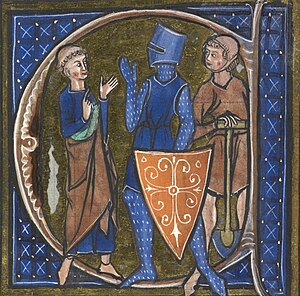
Scottish society in the Middle Ages is the social organisation of what is now Scotland between the departure of the Romans from Britain in the fifth century and the establishment of the Renaissance in the early sixteenth century. Social structure is obscure in the early part of the period, for which there are few documentary sources. Kinship groups probably provided the primary system of organisation and society was probably divided between a small aristocracy, whose rationale was based around warfare, a wider group of freemen, who had the right to bear arms and were represented in law codes, above a relatively large body of slaves, who may have lived beside and become clients of their owners.
From the twelfth century there are sources that allow the stratification in society to be seen in detail, with layers including the king and a small elite of mormaers above lesser ranks of freemen and what was probably a large group of serfs, particularly in central Scotland. In this period the feudalism introduced under David I meant that baronial lordships began to overlay this system, the English terms earl and thane became widespread. Below the noble ranks were husbandmen with small farms and growing numbers of cottars and gresemen (grazing tenants) with more modest landholdings. The combination of agnatic kinship and feudal obligations has been seen as creating the system of clans in the Highlands in this era. Scottish society adopted theories of the three estates to describe its society and English terminology to differentiate ranks. Serfdom disappeared from the records in the fourteenth century and new social groups of labourers, craftsmen and merchants, became important in the developing burghs. This led to increasing social tensions in urban society, but, in contrast to England and France, there was a lack of major unrest in Scottish rural society, where there was relatively little economic change. (Full article...)
Romanticism in Scotland was an artistic, literary and intellectual movement that developed between the late eighteenth and the early nineteenth centuries. It was part of the wider European Romantic movement, which was partly a reaction against the Age of Enlightenment, emphasising individual, national and emotional responses, moving beyond Renaissance and Classicist models, particularly into nostalgia for the Middle Ages. The concept of a separate national Scottish Romanticism was first articulated by the critics Ian Duncan and Murray Pittock in the Scottish Romanticism in World Literatures Conference held at UC Berkeley in 2006 and in the latter's Scottish and Irish Romanticism (2008), which argued for a national Romanticism based on the concepts of a distinct national public sphere and differentiated inflection of literary genres; the use of Scots language; the creation of a heroic national history through an Ossianic or Scottian 'taxonomy of glory' and the performance of a distinct national self in diaspora.
In the arts, Romanticism manifested itself in literature and drama in the adoption of the mythical bard Ossian, the exploration of national poetry in the work of Robert Burns and in the historical novels of Walter Scott. Scott also had a major impact on the development of a national Scottish drama. Art was heavily influenced by Ossian and a new view of the Highlands as the location of a wild and dramatic landscape. Scott profoundly affected architecture through his re-building of Abbotsford House in the early nineteenth century, which set off the boom in the Scots Baronial revival. In music, Burns was part of an attempt to produce a canon of Scottish song, which resulted in a cross fertilisation of Scottish and continental classical music, with romantic music becoming dominant in Scotland into the twentieth century. (Full article...)
In the arts, Romanticism manifested itself in literature and drama in the adoption of the mythical bard Ossian, the exploration of national poetry in the work of Robert Burns and in the historical novels of Walter Scott. Scott also had a major impact on the development of a national Scottish drama. Art was heavily influenced by Ossian and a new view of the Highlands as the location of a wild and dramatic landscape. Scott profoundly affected architecture through his re-building of Abbotsford House in the early nineteenth century, which set off the boom in the Scots Baronial revival. In music, Burns was part of an attempt to produce a canon of Scottish song, which resulted in a cross fertilisation of Scottish and continental classical music, with romantic music becoming dominant in Scotland into the twentieth century. (Full article...)

William Montgomerie (1797–1856) was a Scottish military doctor with the East India Company, and later head of the medical department at Singapore. He is best known for promoting the use of gutta-percha in Europe. This material was an important natural rubber that made submarine telegraph cables possible. Montgomerie was involved in spice cultivation as head of the Singapore botanical experimental gardens and at his personal estate in Singapore. The latter never became economically viable, but he received a Society of Arts gold medal for nutmeg cultivation. He was also responsible for building the first lunatic asylum in Singapore. Montgomerie died at Barrackpore in India a few years after taking part in the Second Anglo-Burmese War as Superintendent Surgeon. (Full article...)

Titan Clydebank, more commonly known as the Titan Crane is a 150-foot-high (46 m) cantilever crane at Clydebank, West Dunbartonshire, Scotland. It was designed to be used in the lifting of heavy equipment, such as engines and boilers, during the fitting-out of battleships and ocean liners at the John Brown & Company shipyard. It was also the world's first electrically powered cantilever crane, and the largest crane of its type at the time of its completion.
Situated at the end of a U-shaped fitting out basin, the crane was used to construct some of the largest ships of the 20th century, including the Queen Mary, Queen Elizabeth and Queen Elizabeth 2. The Category A Listed historical structure was refurbished in 2007 as a tourist attraction and shipbuilding museum. It is featured on the current Clydesdale Bank £5 note. (Full article...)

The mountains and hills of the British Isles are categorised into various lists based on different combinations of elevation, prominence, and other criteria such as isolation. These lists are used for peak bagging, whereby hillwalkers attempt to reach all the summits on a given list, the oldest being the 282 Munros in Scotland, created in 1891.
A height above 2,000 ft, or more latterly 610 m, is considered necessary to be classified as a mountain – as opposed to a hill – in the British Isles. With the exception of Munros, all the lists require a prominence above 15 metres (49.21 ft). A prominence of between 15 and 30 metres (49.21 and 98.43 ft) (e.g. some Nuttalls and Vandeleur-Lynams), does not meet the International Climbing and Mountaineering Federation (UIAA) definition of an "independent peak", which is a threshold over 30 metres (98 ft). Most lists consider a prominence between 30 and 150 metres (98.43 and 492.1 ft) as a "top" (e.g. many Hewitts and Simms). Marilyns, meanwhile, have a prominence above 150 metres (492.1 ft), with no additional height threshold. They range from small 150-metre (490 ft) hills to the largest mountains. Prominences above 600 metres (1,969 ft), meet the P600 (the "Majors") classification, which is the UIAA international classification of a "major" mountain. (Full article...)
The 1873–74 Scottish Cup – officially the Scottish Football Association Challenge Cup – was the first season of Scotland's most prestigious football knockout competition. A total of 16 teams from the west of Scotland entered the competition, but only 14 played a match after two teams withdrew. The competition began with a match between Renton and Kilmarnock on 18 October 1873 and concluded with the final on 21 March 1874. After 16 matches and 38 goals, the inaugural cup was won by Queen's Park who defeated fellow Glasgow club Clydesdale 2–0 in the final.
The sixteen teams that entered the competition consisted of the eight founder members of the Scottish Football Association (SFA) – namely Clydesdale, Dumbreck, Eastern, Granville, Kilmarnock, Queen's Park, Vale of Leven and the 3rd Lanarkshire Rifle Volunteers – as well as Alexandra Athletic, Blythswood, Callander, Dumbarton, Renton, Rovers, Southern and Western. Subscription fees from 15 of these clubs were used to pay for the Scottish Cup trophy which the teams would compete for. Unlike the FA Cup, the original trophy is still awarded to the winners of the competition. It is the oldest trophy in association football and the oldest national trophy in the world. (Full article...)
The sixteen teams that entered the competition consisted of the eight founder members of the Scottish Football Association (SFA) – namely Clydesdale, Dumbreck, Eastern, Granville, Kilmarnock, Queen's Park, Vale of Leven and the 3rd Lanarkshire Rifle Volunteers – as well as Alexandra Athletic, Blythswood, Callander, Dumbarton, Renton, Rovers, Southern and Western. Subscription fees from 15 of these clubs were used to pay for the Scottish Cup trophy which the teams would compete for. Unlike the FA Cup, the original trophy is still awarded to the winners of the competition. It is the oldest trophy in association football and the oldest national trophy in the world. (Full article...)
Ibrox Stadium (Scottish Gaelic: Stadium Ibrox) is a football stadium on the south side of the River Clyde in the Ibrox area of Glasgow, Scotland. The home of Scottish Premiership team Rangers Football Club, Ibrox is the third largest football stadium in Scotland, with an all-seated capacity of 50,987. The stadium was designed by renowned football stadium architect Archibald Leitch, with renovations to the stadium between 1978 and 1981, as well as 1990 and 1991, being designed by The Miller Partnership and Gareth Hutchison respectively.
Opened as Ibrox Park in 1899, it suffered a disaster in 1902 when a wooden terrace collapsed. Vast earthen terraces were built in its place, and a main stand, now a listed building, in 1928. A British record crowd of 118,567 gathered in January 1939 for a league match with Celtic. After another disaster in 1971, the stadium was largely rebuilt. The vast bowl-shaped terracing was removed and replaced by three rectangular, all-seated stands by 1981. After renovations were completed in 1997, the ground was renamed Ibrox Stadium. (Full article...)
Lists of featured content
| This is a list of recognized content, updated weekly by JL-Bot (talk · contribs) (typically on Saturdays). There is no need to edit the list yourself. If an article is missing from the list, make sure it is tagged (e.g. {{WikiProject Scotland}}) or categorized correctly and wait for the next update. See WP:RECOG for configuration options. |
Featured articles
- Áedán mac Gabráin
- Anglo-Scottish war (1650–1652)
- Anne, Queen of Great Britain
- Anne of Denmark
- HMS Argus (I49)
- Japanese battleship Asahi
- Battle of Blenheim
- Blue men of the Minch
- William Bruce (architect)
- William Speirs Bruce
- Burke and Hare murders
- Burnt Candlemas
- Constantine II of Scotland
- Cullen House
- David I of Scotland
- Walter Donaldson (snooker player)
- Donnchadh, Earl of Carrick
- Alec Douglas-Home
- Battle of Dunbar (1650)
- Edward I of England
- Elgin Cathedral
- Queen Elizabeth The Queen Mother
- Fauna of Scotland
- From the Doctor to My Son Thomas
- Rachel Chiesley, Lady Grange
- Margaret Macpherson Grant
- Great North of Scotland Railway
- Bryan Gunn
- Battle of Halidon Hill
- HMS Hood
- Battle of Inverkeithing
- James II of England
- James VI and I
- Jocelin of Glasgow
- Kelpie
- John Knox
- Elizabeth Maitland, Duchess of Lauderdale
- Gregor MacGregor
- Mary, Queen of Scots
- Murray Maxwell
- William McGregor (football)
- Nebula Science Fiction
- Neilston
- Nuckelavee
- Order of the Thistle
- Pitfour estate
- HMS Ramillies (07)
- Renewable energy in Scotland
- Representative peer
- HMS Royal Oak (08)
- Scotland in the High Middle Ages
- Scotland national football team
- Scottish National Antarctic Expedition
- Shapinsay
- Isle of Skye
- Charlotte Stuart, Duchess of Albany
- HMS Vanguard (23)
- Second War of Scottish Independence
- John Wark
- Westminster Assembly
- John Michael Wright
Former featured articles
Good articles
- A82 road
- 2001 Scottish Masters
- 2002 Scottish Masters
- 2014 Scottish Labour leadership election
- 2022 Aberdeen City Council election
- 2022 Aberdeenshire Council election
- 2022 Angus Council election
- 2022 Argyll and Bute Council election
- 2022 Clackmannanshire Council election
- 2022 East Ayrshire Council election
- 2022 Glasgow City Council election
- 2022 North Ayrshire Council election
- 2022 South Ayrshire Council election
- 2022 South Lanarkshire Council election
- Aberdeen F.C.
- Aberdeen F.C.–Rangers F.C. rivalry
- Aberdour Castle
- William Adam (architect)
- Arbroath
- Architecture of Scotland
- Architecture in early modern Scotland
- Architecture in modern Scotland
- Architecture of Scotland in the Industrial Revolution
- Architecture of Scotland in the Middle Ages
- Architecture of Scotland in the Roman era
- Architecture of Scotland in the prehistoric era
- Isle of Arran
- Art in Medieval Scotland
- Art in early modern Scotland
- Art in modern Scotland
- James Balfour (died 1845)
- John Barrowman
- Battle of Barry
- Jim Baxter
- Ian Begg (architect)
- Ben Nevis
- Lewis Benson (boxer)
- Guy Berryman
- The Bhoys from Seville
- Billy Boys
- The Black Island
- HMS Bonaventure (31)
- Boobrie
- Eilley Bowers
- Bill Bowman (Scottish politician)
- British Army
- British people
- Gordon Brown
- Brownie (folklore)
- Alexander Buchan (artist)
- Calendar (New Style) Act 1750
- James Campbell (British Army officer, died 1745)
- Camus Cross
- Thomas Carlyle
- Castles in Scotland
- Celtic F.C. in European football
- Celtic Park
- Erik Chisholm
- Church architecture in Scotland
- Winston Churchill
- Clan Maclachlan
- Clydesdale horse
- HMS Conqueror (1911)
- The Cookery Book of Lady Clark of Tillypronie
- Coxton Tower
- Craigiehall
- Lord Ninian Crichton-Stuart
- Cruachan Power Station
- Cullen Old Church
- 1966 European Cup Winners' Cup final
- The Daily Mash
- Dandie Dinmont Terrier
- Ruth Davidson
- Demographic history of Scotland
- Paul Dickov
- Mary Docherty
- Donkey Punch (novel)
- Doune Castle
- Dowhill Castle
- Dubh Artach
- Andrew Dudley
- Duncraig Castle
- Dunnottar Castle
- Dunrobin Castle
- Dunstaffnage Castle
- East Kirkton Quarry
- East Stirlingshire F.C.
- Easter Road
- Economy of Scotland in the Middle Ages
- Economy of Scotland in the early modern period
- Edinburgh Castle
- University of Edinburgh
- Edinburgh Zoo
- Education in Medieval Scotland
- Education in early modern Scotland
- Edzell Castle
- Eenoolooapik
- Eidyn
- Elcho Castle
- English invasion of Scotland (1400)
- Eriskay Pony
- Estate houses in Scotland
- 1884 FA Cup final
- Edward G. Faile
- Fairy Flag
- Falkirk Wheel
- Family in early modern Scotland
- James Ferguson, Lord Pitfour
- James Ferguson (Scottish politician)
- Finnieston Crane
- Flag of Scotland
- Flora of Scotland
- Sir Ewan Forbes, 11th Baronet
- Forglen House
- Forth Bridge
- Forth Valley Royal Hospital
- Dario Franchitti
- Château Gaillard
- Ryan Gauld
- Geography of Scotland in the Middle Ages
- Geography of Scotland in the early modern era
- Geology of Scotland
- Giffnock
- Gilli (Hebridean earl)
- Glass Swords
- The Glenlivet distillery
- Glenrothes
- Glorious Revolution in Scotland
- Government in early modern Scotland
- Government in medieval Scotland
- Isobel Gowdie
- Grey Gowrie
- John Gregorson Campbell
- Hampden Park
- Hibernian F.C.
- Highland cattle
- Highlands and Islands Alliance
- Lists of mountains and hills in the British Isles
- Hillforts in Scotland
- History of Scotland
- History of agriculture in Scotland
- Mary Hogarth
- Housing in Scotland
- How the Scots Invented the Modern World
- Leslie Hunter
- HMS Hurst Castle
- Ibrox Stadium
- 1902 Ibrox disaster
- Illieston House
- Inchdrewer Castle
- Inner Hebrides
- James Innes (British Army officer, died 1759)
- Charles Irving (surgeon)
- Islands of the Clyde
- Islay
- James I of Scotland
- Bert Jansch
- Jarlshof
- Jocky Wilson Cup
- Kelvin Scottish
- Battle of Kinghorn
- Kirkandrews, Dumfries and Galloway
- Kirkcaldy
- Kirkcudbright Tolbooth
- Labour Party of Scotland
- Johann Lamont
- Landscape painting in Scotland
- Billy Liddell
- Literature in early modern Scotland
- Kim Little
- Loch Arkaig treasure
- Loch Henry
- Lochleven Castle
- RAF Lossiemouth
- Murder of Alesha MacPhail
- Clan MacAulay
- Doris Mackinnon
- Sorley MacLean
- Richard Madden
- SS Manasoo
- James Clerk Maxwell
- Maybole Castle
- James McAvoy
- Stuart McCall
- Angus McDonald (Virginia militiaman)
- McEwan's
- Ewan McGregor
- John George McTavish
- Johnny McNichol
- Meantime (book)
- Mingulay
- Colin Mitchell
- Michelle Mone, Baroness Mone
- Monifieth
- William Montgomerie
- James Murray, Lord Philiphaugh
- Music in early modern Scotland
- John Mylne (died 1667)
- The National (Scotland)
- John Ogilby
- One Kiss
- Orkney
- Outer Hebrides
- Paisley witches
- Papa Stour
- Partick Thistle F.C.
- Portrait painting in Scotland
- Potion (song)
- Prehistoric art in Scotland
- Raasay
- RAF Machrihanish
- Ragnall ua Ímair
- Alex Raisbeck
- Rangers F.C. signing policy
- Renaissance in Scotland
- Richard Rennison
- Rockstar Dundee
- Romanticism in Scotland
- Andrew Ross (rugby union, born 1879)
- Royal Banner of Scotland
- Rusco Tower
- St Margaret's Church, Aberlour
- St Peter's Roman Catholic Church, Buckie
- St Rufus Church
- Scandinavian Scotland
- Schiehallion experiment
- Scotland during the Roman Empire
- Scotland in the Middle Ages
- Scotland in the early modern period
- Scotland in the late Middle Ages
- Scotland in the modern era
- Scotland national football team manager
- Scotland under the Commonwealth
- Scottish art
- 1999 Scottish Challenge Cup final
- 2002 Scottish Challenge Cup final
- 2007 Scottish Challenge Cup final
- Scottish Challenge Cup
- 1873–74 Scottish Cup
- 2012 Scottish Cup final
- 2019 Scottish Open (snooker)
- 1971 Scottish soldiers' killings
- Scottish Terrier
- Scottish art in the eighteenth century
- Scottish art in the nineteenth century
- Scottish religion in the eighteenth century
- Scottish religion in the seventeenth century
- Scottish society in the Middle Ages
- Scottish society in the early modern era
- Scuttling of the German fleet at Scapa Flow
- Sea Mither
- Bill Shankly
- Shetland
- Shieling
- Sieges of Berwick (1355 and 1356)
- Ian Smith (rugby union, born 1903)
- Jimmy Speirs
- Staffa
- Jessie Stephen
- Alexander Stoddart
- Stoor worm
- John Struthers (anatomist)
- Charles Edward Stuart
- Sundrum Castle
- Philipp Tanzer
- Tay Whale
- D'Arcy Wentworth Thompson
- Thurso
- Tibbers Castle
- Titan Clydebank
- Torf-Einarr
- Tradeston Flour Mills explosion
- Trident (UK nuclear programme)
- USS Tucker (DD-374)
- German submarine U-27 (1936)
- Urquhart Castle
- James Walker (Australian politician)
- James Walker (Royal Navy officer)
- William Middleton Wallace
- Warfare in Medieval Scotland
- Warfare in early modern Scotland
- Water bull
- West Highland White Terrier
- Robert White (Virginia physician)
- Krysty Wilson-Cairns
- Witch trials in early modern Scotland
- Andrew Wodrow
- Women in early modern Scotland
Former good articles
- Alexander Bain (inventor)
- Billy Bremner
- William Buchanan (locomotive designer)
- Canadian Gaelic
- Andrew Carnegie
- Carnoustie
- Coatbridge
- Catherine Cranston
- Arthur Conan Doyle
- Dundee United F.C.
- Steve Evans (footballer, born 1962)
- Evanton
- Forth Road Bridge
- Glasgow
- Glasgow, Paisley, Kilmarnock and Ayr Railway
- University of Glasgow
- Frank Hadden
- Halloween
- David Hume
- Jordanhill railway station
- Deborah Kerr
- Lothian Buses
- Gillian McKeith
- Andy Murray
- Picts
- Scotland
- Scots language
- Still Game
- Alec Sutherland
- Tay Bridge
- Treasure Island
- William Morrison (chemist)
Featured lists
- List of islands of Scotland
- List of Celtic F.C. managers
- List of Scottish Football League clubs
- List of Scotland international footballers
- List of Scotland ODI cricketers
- List of Scotland national football team hat-tricks
- List of Scottish football champions
- List of Scottish football clubs in the FA Cup
- PFA Scotland Players' Player of the Year
- SFWA Footballer of the Year
- Scotland national football team results (1872–1914)
- Timeline of prehistoric Scotland
- Timeline of Scottish football
Featured pictures
-
13-06-07 RaR Biffy Clyro Simon Neil 02
-
Aerial View of Edinburgh, by Alfred Buckham, from about 1920
-
Arthur-James-Balfour-1st-Earl-of-Balfour
-
CAMPBELL, George W-Treasury (BEP engraved portrait)
-
Charles Robert Leslie - Sir Walter Scott - Ravenswood and Lucy at the Mermaiden's Well - Bride of Lammermoor
-
Common seal (Phoca vitulina) 2
-
Dalziel Brothers - Sir Walter Scott - The Talisman - Sir Kenneth before the King
-
Daniel Craig McCallum by The Brady National Photographic Art Gallery
-
David Livingstone by Thomas Annan
-
Dunrobin Castle -Sutherland -Scotland-26May2008 (2)
-
Edinburgh Castle from Grass Market
-
Eilean Donan Castle, Scotland - Jan 2011
-
Falkirk Wheel Timelapse, Scotland - Diliff
-
FalkirkWheelSide 2004 SeanMcClean
-
Gavin Hamilton - Coriolanus Act V, Scene III edit2
-
Jaguar at Edinburgh Zoo
-
Jeremiah Gurney - Photograph of Euphrosyne Parepa-Rosa
-
Loch Torridon, Scotland
-
Mount Stuart House 2018-08-25
-
N. M. Price - Sir Walter Scott - Guy Mannering - At the Kaim of Derncleugh
-
NEWScotland-2016-Aerial-Blackness Castle 01
-
Nils Olav inspects the Kings Guard of Norway after being bestowed with a knighthood at Edinburgh Zoo in Scotland
-
Paisley Abbey Interior East
-
Paisley Abbey from the south east
-
Prince James Francis Edward Stuart by Alexis Simon Belle
-
Robert William Thomson - Illustrated London News March 29 1873
-
Scotland-2016-West Lothian-Hopetoun House 02
-
Sgùrr nan Gillean from Sligachan, Isle of Skye, Scotland - Diliff
-
Sir Anthony Van Dyck - Charles I (1600-49) - Google Art Project
-
St Matthew's Church - Paisley - Interior - 5
-
Synthetic Production of Penicillin TR1468
-
The Air Ministry, 1939-1945. CH10270 – Edit 1
-
The Monarch of the Glen, Edwin Landseer, 1851
-
The Skating Minister
-
Thomas Keene in Macbeth 1884 Wikipedia crop
-
View of loch lomond
-
Wemyss Bay railway station concourse 2018-08-25 2
-
William John Macquorn Rankine by Thomas Annan
Get involved
For editor resources and to collaborate with other editors on improving Wikipedia's Scotland-related articles, see WikiProject Scotland.
To get involved in helping to improve Wikipedia's Scotland related content, please consider doing some of the following tasks or joining one or more of the associated Wikiprojects:
- Visit the Scottish Wikipedians' notice board and help to write new Scotland-related articles, and expand and improve existing ones.
- Visit Wikipedia:WikiProject Scotland/Assessment, and help out by assessing unrated Scottish articles.
- Add the Project Banner to Scottish articles around Wikipedia.
- Participate in WikiProject Scotland's Peer Review, including responding to PR requests and nominating Scottish articles.
- Help nominate and select new content for the Scotland portal.
Do you have a question about The Scotland Portal that you can't find the answer to?
Post a question on the Talk Page or consider asking it at the Wikipedia reference desk.
Related portals
Wikipedia in other relevant languages
Associated Wikimedia
The following Wikimedia Foundation sister projects provide more on this subject:
-
Commons
Free media repository -
Wikibooks
Free textbooks and manuals -
Wikidata
Free knowledge base -
Wikinews
Free-content news -
Wikiquote
Collection of quotations -
Wikisource
Free-content library -
Wikispecies
Directory of species -
Wikiversity
Free learning tools -
Wikivoyage
Free travel guide -
Wiktionary
Dictionary and thesaurus






